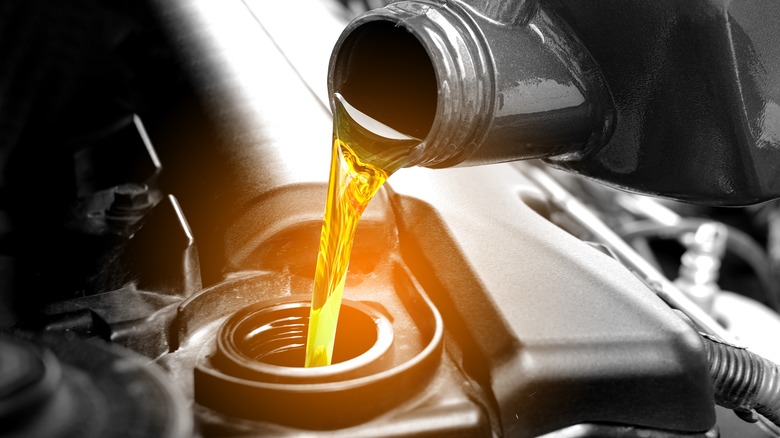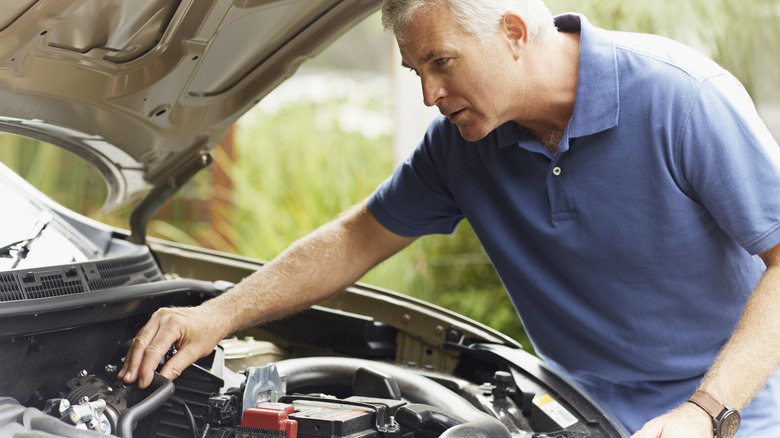How To Tell If The Rear Main Seal Is Leaking On Your Car


Me dia/Shutterstock
From engine oil to gas, our vehicles are full of components that need to be carefully maintained and kept in the section of the vehicle where they belong. Leaks, of various sorts, can be very dangerous. This is particularly problematic because it isn’t always clear if there’s a leak.
In the case of something like brake fluid, a distinctive stain beneath your vehicle can make it all too clear that some precious liquid has escaped (it can be important to change your brake fluid regularly for reasons such as this). This can also be the case if your rear main seal has been compromised. At the same time, though, car maintenance can be a tricky matter, and it’s rarely plain and simple like this. Before you know it, you could be driving a vehicle with issues about which you’re unaware.
Let’s explore the function of the rear main seal, the signs and symptoms of such a leak, and what drivers should do to resolve the issue.
What is a vehicle’s rear main seal (and why might it leak)?

Morsa Images/Getty Images
The rear main seal is a complicated component, although its mechanical function is very simple: to protect the interior of your vehicle from leaks and keep engine oil flowing where it’s needed. It’s connected to the engine in the vicinity of the crank shaft, and is typically a simple rubber seal.
As a result of its positioning, the strain it can be placed under, and the durable yet perishable material it’s made from, the rear main seal can wear over time like other components. Should it develop a leak in this manner, it can potentially be very detrimental to the vehicle. Engine oil, after all, is essential in the smooth running (literally) of a vehicle, and if it drains away unbeknownst to the driver, it can cause quite some damage to the engine. It’s an issue that may escalate over time, and so an important one to diagnose quickly.
What you need to identify, then, are some of the common signs of a rear main seal leak.
The potential signs of a rear main seal leak

Lovethewind/Getty Images
The smaller, unexpected issues that vehicles face can be some of the most expensive to rectify. Regular care and checks, even cursory ones, can save an enormous amount of stress and expense.
The first step in detecting a potential rear main seal leak is a simple one: check the ground. Is there any oil in your garage or parking spot beneath the engine’s location on your vehicle? This could be a solid indicator of just that. If you see a leak but aren’t sure which particular component is the culprit, a look under the hood is in order. By identifying the rear main seal (around the back of the engine, as the name suggests, relative to its location) and doing so, you’ll be able to tell if this is where the oil is coming from.
Such a leak may be noticeable on the inside before reaching the ground, so take a look under the hood at the engine if you notice any general issues that can be associated with a rear main seal leak. These include noticeable losses of fuel efficiency or oil levels that seem to have dropped rather quicker than usual. Hayes European notes that a burnt oil smell is a real indication of danger and potential fire hazard, as “this could be a sign that oil is leaking from the rear main seal and coming into contact with hot engine components.”
What to do if you discover a rear main seal leak

Realpeoplegroup/Getty Images
Most drivers have maintenance jobs they’re comfortable performing themselves and the jobs for which only their mechanics will do. Changing the rear main seal or repairing it in the case of a leak could well trend toward the latter category. So, too, could diagnosing such a leak in the first place. This is because the rear main seal is particularly difficult to get to, surrounded by the transmission as it is.
Combine this the fact that it can be hazardous and increasingly damaging to drive with a leak (or suspected one), and deferring to a professional mechanic will tend to be the safest way to rectify the issue.
Note, however, that it can be a costly process, as removing certain components to access the rear main seal itself as needed takes considerable time. Naturally, there’ll be great variation depending on how extensive the leak is and the level of damage caused, along with other factors like the type of vehicle in question. As such, The Cost Guys estimates that changing/repairing a rear main seal can cost anywhere from $350 up to $2000 or so.



